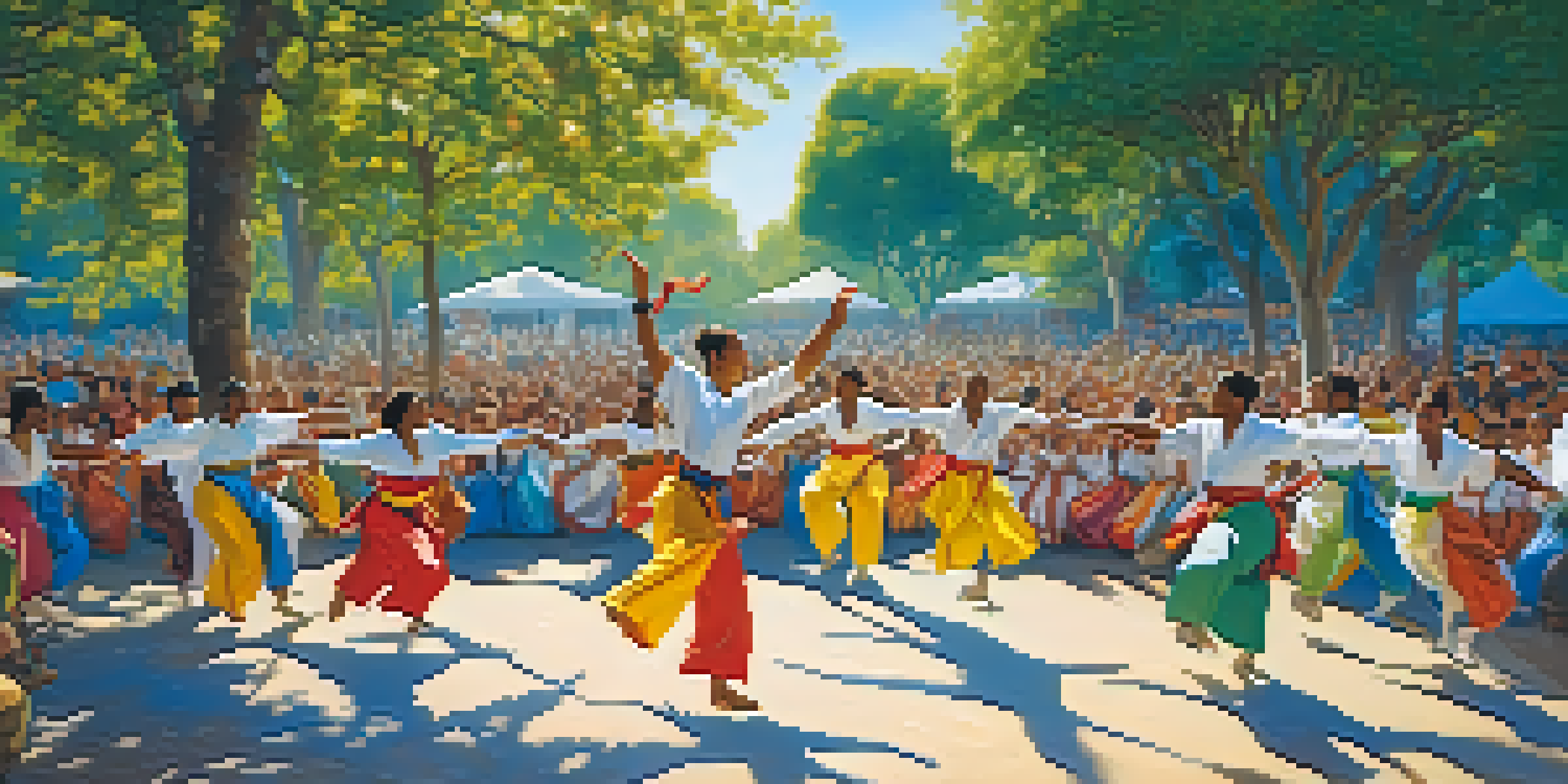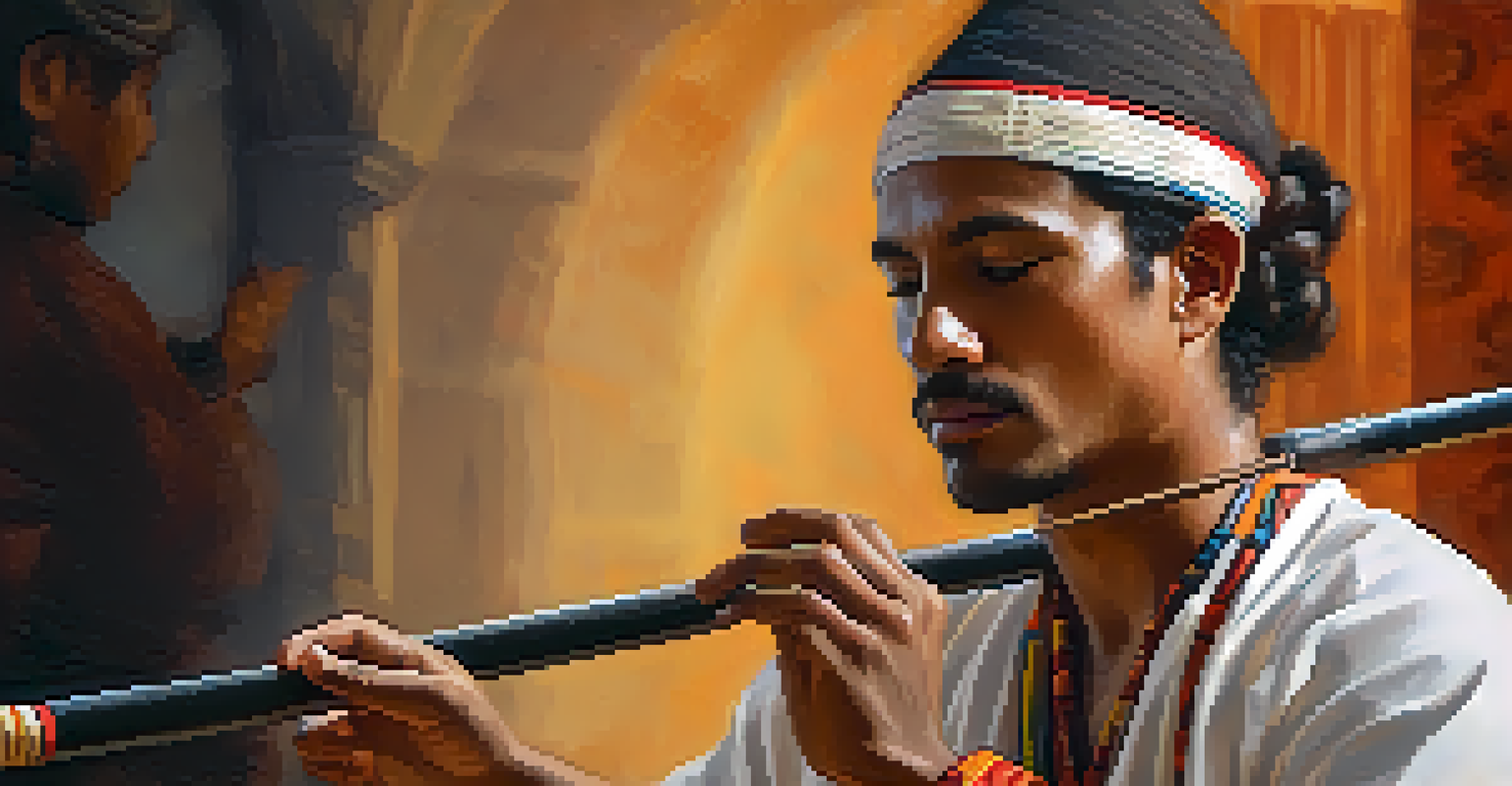Understanding the Importance of Capoeira in Brazilian Culture

Capoeira: A Unique Blend of Dance and Martial Arts
Capoeira is not just a martial art; it's a dynamic fusion of dance, music, and acrobatics. Originating from the African slaves in Brazil, it served as both a means of self-defense and a way to express cultural identity. The fluid movements and rhythmic music create a captivating performance that can mesmerize anyone watching. Importantly, this blend of art forms makes Capoeira a powerful symbol of resilience and creativity.
Capoeira is a dance, a game, and a fight. It is a way of life that embodies the spirit of resistance and resilience.
The game of Capoeira, known as 'jogo', is played in a circle called the 'roda', where participants showcase their skills. Each player adds their unique flair, turning the roda into a vibrant celebration of culture and community. The physicality of Capoeira is matched by its deep-rooted musical tradition, with instruments like the berimbau setting the rhythm. This interplay between movement and music emphasizes the art's holistic nature.
Moreover, Capoeira is often seen as a form of social commentary, reflecting the struggles and triumphs of the Afro-Brazilian community. Through its history, Capoeira has evolved from a tool of resistance to an internationally recognized cultural phenomenon. As such, it plays a crucial role in preserving the narratives and traditions of those who created it, bridging generations and fostering pride in cultural heritage.
A Reflection of Brazilian History and Identity
Capoeira's roots are deeply intertwined with Brazil's history, reflecting the experiences of enslaved Africans. When they were brought to Brazil, they created Capoeira as a way to maintain their cultural identity while under oppression. This art form allowed them to subtly train for resistance while appearing to engage in playful dance. Hence, Capoeira became a symbol of hope and resistance amidst adversity.

As Brazil transitioned through various political and social changes, Capoeira evolved alongside it. Initially banned and persecuted, it eventually gained acceptance and recognition as a legitimate art form. This journey mirrors Brazil's complex history, highlighting themes of struggle, survival, and eventual triumph. Capoeira stands as a testament to the resilience of a culture that refused to be silenced.
Capoeira: Culture and Resilience
Capoeira embodies the struggles and triumphs of the Afro-Brazilian community, symbolizing hope and cultural identity.
Today, Capoeira is celebrated not just in Brazil, but around the world, showcasing its importance in promoting Brazilian identity. The global spread of Capoeira illustrates how cultural practices can transcend borders, fostering understanding and appreciation of diverse traditions. By engaging in Capoeira, practitioners connect with a rich historical narrative that continues to shape Brazil's cultural landscape.
The Role of Community in Capoeira
At its core, Capoeira emphasizes community and collaboration. The roda is a gathering place where individuals come together to share their skills, stories, and experiences. This communal aspect fosters a sense of belonging, as everyone—from beginners to masters—participates in the game. The encouragement and support within the roda create an environment where learning and growth can flourish.
Art is the most beautiful of all lies; it is a way to express emotions that are often too difficult to articulate.
In Capoeira, relationships are built not only through movement but also through shared musical experiences. Participants sing traditional songs that tell stories of struggle, love, and history, reinforcing the collective identity of the group. This musical element enhances the bond among practitioners, as they find common ground through the rhythms and lyrics. It’s a beautiful illustration of how art can unite people.
Moreover, Capoeira serves as a vehicle for social change and empowerment. Many groups use Capoeira as a way to engage youth, teaching them discipline, respect, and cultural pride. This transformative power of Capoeira highlights its role in building stronger communities, as it inspires individuals to work together for a common purpose. Through these connections, Capoeira contributes to a greater sense of social responsibility and community engagement.
Capoeira as a Tool for Cultural Preservation
Capoeira plays a vital role in preserving Afro-Brazilian culture and traditions. As a living art form, it embodies the customs, values, and stories of a community that has faced significant challenges throughout history. By participating in Capoeira, practitioners not only engage in physical activity but also keep their cultural heritage alive for future generations. This sense of continuity is crucial in a rapidly changing world.
The choreography and movements in Capoeira often reflect historical narratives, teaching practitioners about their ancestry and the struggles faced by their forebears. Each kick, spin, and song carries a meaning, connecting the present to the past. In this way, Capoeira serves as an educational tool, promoting cultural awareness and appreciation among both practitioners and spectators alike.
Community and Connection in Capoeira
The roda fosters a sense of belonging and collaboration, allowing practitioners to share skills and build relationships.
Furthermore, Capoeira has gained recognition by UNESCO as part of Brazil's intangible cultural heritage. This acknowledgment highlights the importance of safeguarding such traditions in the face of globalization. By celebrating Capoeira, we ensure that the rich tapestry of Afro-Brazilian culture is honored and preserved, allowing future generations to learn and grow from these powerful stories.
The Global Impact of Capoeira
Capoeira has transcended its origins, becoming a global phenomenon with practitioners in many countries. As people from diverse backgrounds engage in this art form, they contribute to a rich exchange of cultures. This global spread not only highlights the adaptability of Capoeira but also fosters inter-cultural dialogue and understanding. It’s fascinating to see how a traditional Brazilian practice resonates with individuals worldwide.
International Capoeira festivals and workshops create opportunities for practitioners to connect, share, and learn from each other. These gatherings foster a sense of belonging among people from all walks of life, united by their love for Capoeira. This cross-cultural interaction enriches the experience, as participants bring their unique interpretations and styles to the practice. It's like a beautiful tapestry woven from many threads of culture and creativity.
Moreover, the global presence of Capoeira has sparked interest in its music, history, and philosophy. As more people learn about Capoeira, they also discover the broader Afro-Brazilian cultural context, leading to increased appreciation and awareness. This cultural exchange encourages a sense of solidarity among diverse communities, showcasing the unifying power of art in promoting understanding and respect.
Capoeira's Influence on Modern Brazilian Music and Arts
Capoeira's rhythm and energy have significantly influenced Brazilian music and arts. The distinctive sounds of instruments like the berimbau and pandeiro have permeated other musical genres, from samba to bossa nova. This fusion has enriched Brazil's diverse music scene, creating new styles and sounds that reflect the country's cultural melting pot. It’s a testament to how Capoeira continually shapes the artistic landscape.
The movements and expressions found in Capoeira have also inspired various forms of visual art, dance, and theater. Artists often draw upon the fluidity and athleticism of Capoeira to create dynamic performances that captivate audiences. This interplay between Capoeira and other art forms showcases the versatility and creativity inherent in Brazilian culture, as it evolves and adapts over time.
Capoeira's Global Influence
Capoeira has transcended borders, promoting cultural exchange and appreciation while inspiring modern music and arts.
Furthermore, the global interest in Capoeira has led to collaborations between artists across different genres and cultures. These partnerships not only elevate Capoeira’s profile but also create innovative works that celebrate its essence. By blending Capoeira with other artistic expressions, creators continue to explore and expand the boundaries of Brazilian art, ensuring its relevance in contemporary society.
Capoeira: A Path to Personal Growth and Development
Practicing Capoeira offers numerous benefits that extend beyond physical fitness. The discipline required to master its intricate movements encourages focus, perseverance, and self-confidence. As practitioners progress, they not only improve their skills but also develop a deeper understanding of themselves. This journey of self-discovery is empowering and can have lasting effects on personal growth.
Moreover, Capoeira fosters a sense of respect and camaraderie among practitioners. The culture emphasizes values such as humility, cooperation, and mutual support, creating a positive environment for learning. This supportive community contributes to personal development, as individuals learn to appreciate their strengths and those of others. It's a nurturing space where everyone can flourish together.

Finally, the mental and emotional aspects of Capoeira play a crucial role in personal well-being. The combination of physical movement, music, and social interaction can reduce stress and enhance mood. Many practitioners find joy and fulfillment in their Capoeira journey, making it not just an art form but a holistic approach to a healthier, more balanced life. In this way, Capoeira is more than a practice—it’s a pathway to becoming the best version of oneself.